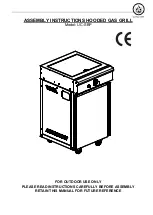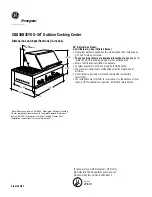
Australia’s Leading Barbecue
BeefEater Barbecues
17
Condition
Cleaning Agents
Precautions
Non washable deposits
Heavy grease
Soap, Liquid Detergents, or Powder
Detergents with warm water. Methylated
Spirits may be used before final wash with
detergent.
Concentrated Detergent. Domestic cleaning
powders. Recommended stainless
steel cleaners.
Avoid scratching. Do not use cleaners
containing bleaching agents. Rinse with clean
water to remove residual cleaning compounds
and dry before covering. Only use mild
detergents on barbecue fascia.
Do not use steel wool. Rub in straight lines
along the polish pattern. Avoid scratching.
scratching. Rinse with clean water and dry.
Readily removed stains.
Light grease.
Routine cleaning.
Salt spray.
Care and Maintenance
Care should be taken with all cleaning agents to avoid damage to any associated non-stainless steel components. Fire, safety
and protective clothing regulations should be closely adhered to.
Service and Maintenance Schedule
Each Use
Every 6 Months
Check gas supply hose(s) for cracks and leaks
Check gas regulator for leaks
Check that all gas fittings are tight
Clean and inspect barbecue burners
Clean and inspect gas injectors
Frequency
Inspect ignition system
Inspect gas control valves
By Authorised
Every 2 Years
Check the gas control valve on the cylinder
Clean and inspect Vaporizer grids and reflectors
occur on any exposed metal surface if it is not protected
from the elements. Even stainless steel can be affected by
long term exposure to the elements. To prevent exposure to
the elements, store your barbecue, hood and trolley under
the protection of a purpose made cover.
Do
• Wash regularly with warm soapy water or detergent
using a clean cloth and, if necessary, a soft bristle brush.
• Remove non-washable deposits using an approved
cleaner.
• In the case of stainless steel, clean in one direction only,
along the original polish lines.
• Rinse well with clean water and wipe dry
.
• Keep barbecue covered when not in use. eg polyester
barbecue cover.
Don’t
• Use steel wool or metallic scrapers to remove non-
washable deposits.
• Allow grease or dirt to accumulate or to dry out and
harden.
• Use cleaners containing harsh abrasives or high bleach
content.
avoid unwanted marks.
Near the ocean or salt-water environment, wash regularly,
rinse and then dry before covering. Covering a salt sprayed
stainless steel product while still wet will allow salt deposits
to form, causing rust to form even on very high grade
stainless.
Discoloration Of Stainless Steel
The discoloration of stainless steel, caused by high heat is
caused by
Chromium Oxide
and sometimes appears as a light
brown colouring over the surface of the steel. In most cases,
this discoloration can be removed with a suitable stainless
steel polish. Note: Discoloration of the stainless steel is not
covered under warranty
.
Porcelain Enamel Cleaning And
Maintenance
After the appliance has been used, wash down the surfaces
with hot soapy water. Near the ocean or salt-water
environment, wash regularly, rinse and then dry before
covering. Highly caustic cleaners should be avoided.
Rust
Cast iron and steel are metals and will rust if you do not
provide sufficient maintenance and care. Rust occurs when
the surface of the metal starts to oxidise. Generally, rust will
Service And Maintenance
This appliance should be checked and serviced by an authorised service person every 2 years to ensure the appliance
remains in a safe operation condition. These services are not covered by warranty
.








































